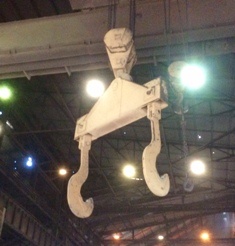It would be very interesting to know how many non conformances have been raised by auditors, safety officers and consultants where hooks and attaching devices have been found in use without safety latches.
In fact, it would be safe to say that even persons without any special knowledge of the OHSA or the Driven Machinery Regulations would point out a hook without a latch as “wrong”.
While no one can argue that safety latches are a safety device, and an important one at that, experience shows that latches are not a feasible control measure in all instances.
Is the use of safety latches however a strict legal requirement? We submit that this is another of those examples where common wisdom is not necessarily based on a factual interpretation of the legal rules.
Legal situation
In terms of placing the use of safety latches on lifting equipment load attachments in context, the general legal context should first be considered.
When investigating potential liability, legal professionals often view a problem statement using the worst case scenario. In this instance this would mean a fatal accident as a result of a destabilised or falling load where no safety latch was fitted to a hook or attachment device.
While our natural inclination would be to consult the OHSA or its Regulations, the worst case scenario would not be a prosecution in terms of the OHSA but a charge of culpable homicide based on a negligent killing. In terms of identifying guilt, the question would be whether someone acted negligently, where the well known reasonable person test would be applied.
Although much simplified, this will entail establishing what a reasonable person would have done in a similar situation, with the specific issues to be dealt with being:
- Whether a reasonable person would have foreseen the possibility of the accident occurring,
- Whether a reasonable person, taking into account the first question, would have taken steps to prevent it from happening, (for example using a hook with a latch)
- And then thirdly, comparing what the accused (engineer, manager, foreman, artisan, employee etc.) did in comparison to what the fictitious reasonable person would have done.
It is moot that most persons would assume that latches should be fitted to lifting attachments and hooks. Where a specific application makes this impractical, positive proof would then need to be offered to substantiate the argument that using a latch was not reasonably practicable.
As a minimum a defence (where a latch was not fitted for practical reasons) would have to be based on the first two questions of the reasonable person test, i.e. that the reasonable person would not foresee, or that such an incident was foreseeable but that reasonable steps (excluding a latch) were taken. We submit that in both instances a formal risk assessment would be a minimum requirement.
Where a charge of culpable homicide is not the worst case scenario, the next in line would be a charge in terms of Section 38(2) of the OHSA, i.e. where an accident could have led to a persons death (R 100 000 fine or 2 years’ imprisonment). In essence, the state would have to prove that the employer failed to comply with its principal duties and that the non compliance led to the accident. These principal duties would primarily focus on Section 8 of the Act, with the main elements being risk assessment and corresponding controls.
Next in line would be a prosecution in terms of the Driven Machinery Regulations. Where the tests used in determining liability in either scenario 1 or 2 above contain elements of subjectivity, the test for liability under the Regulations would be more objective in the sense that a specific obligation must not have been met.
With regards to the use of a latch, Driven Machinery Regulation 18(4) should be consulted:
(4) The user shall cause every hook or any other load-attaching device which forms an integral part of a lifting machine to be so designed or proportioned that accidental disconnection of the load under working conditions cannot take place.
It should be obvious from the above that safety latches are not mandatory on all hooks, but that thought must go into ensuring that accidental disconnection does not take place.
Duties of the Manufacturer
In our opinion, the duties and responsibilities of manufacturers in terms of the OHSA are often overlooked.
In terms of Section 10 of the Act, all manufacturers have a twofold duty when thye manufacture or supply articles and components for use at a place of work:
- That the article is safe to use when properly used (implying the manufacturer must provide details on what “proper” use is)
- And complies with all legal prescriptions
The implication is thus that the manufacturer (or supplier) must provide articles that are fit for purpose. This then becomes a tool for the employer or user. Where a latch would be impractical, the manufacturer should be informed of the specific application and practical considerations. The impact of this is that the manufacturer would have a legal obligation to provide a hook which is safe to use. This process would of course have to be documented.
The converse obviously also holds true. If the manufacturer provided a hook with a latch, removing the latch would lead to liability. As such, we strongly recommend that no hook or attaching device be modified.
Conclusion
In summary, the conclusion is the following where the use of a latch is not practical:
- Perform a documented product based risk assessment on using an attaching device without a latch (this should be obvious, as risk assessment is a defence under the first two worst case scenarios listed above).
- Identify and implement other engineering controls and administrative controls.
- Draft procedure on use of specific specialist attachment devices without latches.
- Train and assess users, taking care to ensure risks, controls and limitations are assessed.
- Limit extent of potential liability by transferring some risk to the manufacturer. Examples of steps include communicating needs and requirements to manufacturer (manufacturer includes supplier, distributor, agent etc) with request that suitable and safe latchless equipment be provided.
The risk, despite the above, is that an individual inspector, auditor etc. is not satisfied with a hook without a latch based on their misunderstanding of the Regulations, either during a workplace inspection or during an investigation or formal inquiry.
Taking this into account, at the risk of coming across as overcomplicating the issue, we strongly suggest that a formal, documented liability mitigation exercise be followed prior to making use of attaching devices without latches or with installed latches removed.
Jaco Swartz


They say it is as clear as mud. That is exactly what one finds, different interpretations of the requirement placed by the act on the user of lifting equipment and lifting tackle.
1st Price should be the use of tackle fitted with a safety latch. However there are cases that it is impractical and therefore follow the steps as you said in your conclusion. The only difference is that we do not allow for the use of tackle without a safety latch that was originally designed with a safety latch. It must be supplied without a latch from the manufacturer.
Thanks again
Regards
Hi Nicky, agree, if I was in charge of an operation where equipment was used where latches had been removed or damaged and never replaced I would be worried!
Audited a smelter last week where they had been trying to get “exemption” form fitting latches to their ladle hooks without any reply from the DoL for years…
Thanks for initially reminding us of the issue.
Jaco
Very good article on a relevant and much discussed matter among operations & maintenance personnel.
Thank you for the input
Regards
Hi Francois, thanks for taking the time to read!